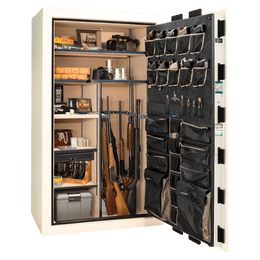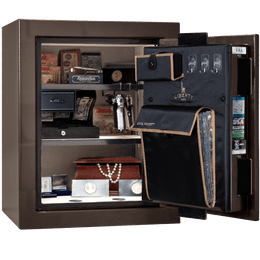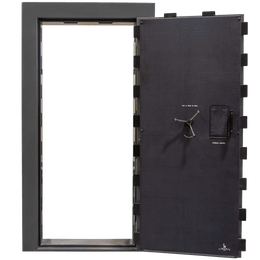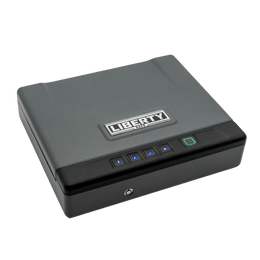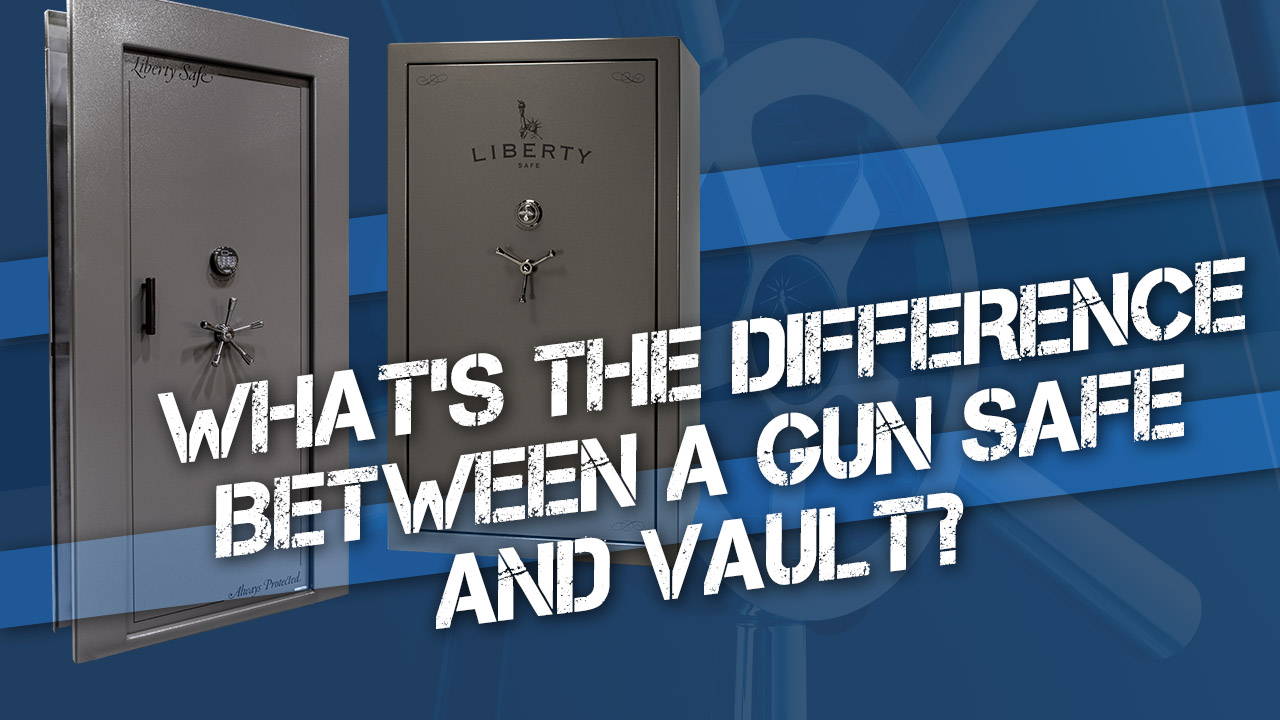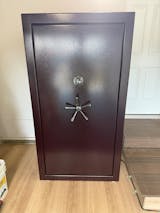Gun safes and gun vaults are two top choices for securing your firearms at home or your place of business. So what’s the difference? We’re going to go over all the nuances, pros, and cons of gun safes and gun vaults for you in this article.
Researching the best home security products
Researching a home safe or secure vault is an important aspect of home security, even if you don’t own any firearms. Everyone needs a safe and secure place to store important documents, valuables, computer backups, family history, photo albums, and other irreplaceable items.
Let’s go over the differences between safes and vaults so you can make an informed decision about what’s the right way to go for you and your home security protocols.
Gun safes vs. gun vaults, pros, and cons
A gun safe, for the purposes of our discussion, is a stand-alone container, usually made of steel, with a secure locking mechanism, a hinged door, and provision inside for storage of firearms and protecting them from theft, unauthorized access, corrosion, and fire damage. Of course, other valuables and items may be stored in a gun safe as well.
A gun vault is a more broadly defined term, but basically, the vault door is integral to creating a gun vault. The vault itself can be any room in your home, place of residence, or office that you secure with a vault door. That room effectively becomes your “gun vault.”
For best results, the floor, walls, and ceiling of a room you wish to turn into your gun vault should be as thick and durable as possible, ideally hardened, reinforced concrete (or solid steel if you can pull that off).
There’s another way the term “gun vault” is sometimes used, though “gun vault” most often refers to a vault room with a vault door securing it. Handgun vaults are small gun safes intended to hold one or two handguns and other small valuables, which keep them secure but available for ready access to the authorized user. But when someone says “gun vault” they’re most often talking about a secure room with a “safe door” or vault door.
Advantages of gun safes
Mobility: Gun safes are readily moved from location to location, and relatively easily installed in your home or office. We recommend qualified, professional safe movers, but in most cases, a few strong guys, some PVC pipe for rollers, and maybe a heavy-duty dolly or hand truck can get a gun safe in or out of the desired location for installation, or if you move homes.
Some of the bigger and heavier gun safe models can come with some caveats about where you install them, such as making sure your floor is rated for the load, but in general, you can put your gun safe wherever you want and bolt it down for safety and increased security.
Cost: A quality gun safe doesn’t have to cost you several thousand dollars. Liberty offers several lines of budget-friendly gun safes that still have serious security ratings and fire protection. And if you figure the cost of the vault door and construction of the safe room/vault, a gun safe is almost always less expensive.
Humidity control: Since the interior of a gun safe is less capacious than a gun vault or safe room, it’s easier to keep the safe at a proper humidity level for maximum protection against corrosion, mold, mildew, and other environmental factors that can harm valuables. A good safe dehumidifier is a must if you live in humid locations.
More convenient access: Since a gun safe can be placed anywhere inside your home or office, you can select the level of convenient access that suits your lifestyle and level of security risk. Safes in gun shops or offices may be accessed many times a day. This isn’t possible with most gun vaults, since one of the primary advantages of the gun vault is that it can be located deep within the home for maximum security and minimal exposure to visitors or customers.
Additionally, gun safes usually come with pre-installed facilities for storing long guns and shelving for storing handguns and other smaller valuables. A vault door is just a door that secures a room; you have to provide the amenities for your valuables inside, at additional cost.
Fire protection: Depending on how you construct the walls of your gun vault or safe room, a gun safe may offer more convenient and even more effective fire protection. All Liberty gun safes are rated for at least 30 minutes of fire protection at 1200° F, and the top models have been tested to survive a full 2.5 hours under those infernal temperatures. Theoretically, your gun safe might survive a home fire better than even the concrete walls that enclose your gun vault. According to one source, “At temperatures of about 1,000 degrees F the compressive strength [of concrete] would be reduced to only 20 to 45 percent of its original value.”
Disadvantages of gun safes
Mobility: Yep, this is also a disadvantage. The very mobility that makes gun safes perfect for easy installation and moving from location to location also means that they are more susceptible to being moved or dragged off by thieves. This is one reason we don’t recommend locating your gun safe in your garage or anywhere with ready outdoor access.
Gun safes should be bolted securely to walls/studs and/or floors/joists, which helps keep the safe from tipping as well as making it more difficult for thieves of opportunity to push the safe over or drag it away with chains and a truck. But compared to a hardened concrete gun vault that’s built as part of your home’s construction, it must be said that a gun safe is certainly more susceptible to being removed or stolen.
Visibility: The ready access to a gun safe that may be a benefit to homeowners or office managers can also be a liability, in that the more people that know about the existence of your gun safe, the greater the chances that one of them will let that fact slip to the wrong sort of person. A gun vault door buried deep in the bowels of your home, and possibly behind a false/concealed door, is less likely to be noticed by casual visitors to your home or customers to your business.
Security: Depending on the construction of the gun vault we’re comparing, a safe may be easier to breach. Nothing on Earth will keep out a determined, knowledgeable thief with the right tools and lots of time. However, cutting or torching through the hardened steel of a gun safe may theoretically be easier and make less of a racket than someone jackhammering through 12 inches of hardened, reinforced concrete.
Advantages of gun vaults
Capacity: A gun safe may hold a few or a few dozen firearms, depending on the size you buy. A gun vault can be as large as you want. We’ve seen some vaults with space for multiple artillery pieces, thousands of guns in display cases, mounted hunting trophies, leather couches, marble floors, and more. You’re only limited by your property line and your wallet.
Versatility: A gun vault can double as a “panic room” or fallout shelter, as well as a place to store all your valuables. Depending on the size of the room, you can keep your food storage, survival packs, and whatever else you like in your gun vault.
More fire retardant options: While a quality gun safe can survive an amazing amount of heat, a gun vault can benefit from integrated, in-room fire protection systems like sprinklers or even halon fire suppression systems.
Potentially greater theft protection: Due to the likely more “hidden” nature of a gun vault, as well as its inability to simply be chained up and dragged off, a gun vault could be said to offer a greater level of theft protection than a gun safe. This depends, of course, on the quality of the construction of the gun vault’s walls, vault door, and door frame.
Cost: Since you can make any suitable room into a gun vault by adding a vault door, the cost can essentially be limited to the door and any systems you wish to be installed in conjunction with it. If you build your home from the start with the provision for a vault room, that cost can be rolled into the price of your home construction, which can make it a little easier to swallow.
Disadvantages of gun vaults
Humidity control and drainage: A gun vault is a larger space than the interior of a gun safe, and if humidity is a problem where you live, you’re going to want to install a quality dehumidifier system in your gun vault, as well as an automatic sump pump in case of water incursion. Many gun vaults are built on or below ground level, and moisture coming through the concrete floor and walls can be an issue, in addition to the potential for flooding due to natural events or broken pipes in the home.
Keeping a large gun vault climate controlled is more difficult and expensive than maintaining the proper conditions inside a gun safe.
Zero mobility: As noted above, you can’t walk off with or move your gun vault. This is a benefit in that it deters the kind of thieves that try to drag off a gun safe, but it also means that you are fully committed to the location of your gun vault, and you can’t just take it with you if you move. You may be able to uninstall your vault door and bring that along with you, but a home buyer will likely pay a premium if you leave it in place for them.
Inconvenient access: As we mentioned above, one of a gun vault’s potential advantages is that it will likely be out of the way, and out of the line of sight of potential ne’er-do-wells. However, this also means that taking a trip to the vault is more of an inconvenience and an occasional thing, rather than something you want to be doing several times a day (or several times an hour).
Heavy construction required: As we pointed out above, ideally you’re going to want to plan for hardened, reinforced concrete walls (or steel plate if you can swing it) for your gun vault. While you CAN install a vault door pretty much anywhere in your home, standard interior walls made of drywall and 2x4 studs won’t prevent access for long.
What is a fire rating?
Different gun safe manufacturers test their safes (or don’t) in different ways, using different protocols. Liberty Safe’s fire protection ratings and testing are based on guidelines developed by the U.S. Department of Commerce National Institute of Standards and Technology (NIST). These guidelines were developed through a full-scale house fire study designed to mimic what happens during a real home fire. The NIST study reported that within the first few minutes of a house fire, temperatures can quickly soar to 1200 degrees F.
Many safe manufacturers base their fire certification on tests that have nothing to do with how fast temperatures heat up in a real fire. In fact, many delay the ramp-up to 1200 degrees over 20-30 minutes. They do this, then claim their gun safes “survived in the furnace at 1200 degrees.” Some even rate their safes as high as 1400 degrees.
Liberty Safe doesn’t play this game. During our fire tests, we quickly ramp up the heat to 1200 degrees within ten minutes. Then we keep it at 1200 degrees throughout the duration of the test to make sure our fire ratings are legitimate. No other safe company does more rigorous fire testing, and no other company has more success stories from real customers whose valuables have survived a fire inside their safe. Liberty gun safes have survived home fires, wildfires… even California’s notorious Camp Fire. See some of our favorite fire survival stories.
Get the best gun safes and gun vaults at Liberty Safe
Whether you elect to choose the best gun safe in America, made in the USA from US steel, or whether you decide a vault door and the resulting gun vault is right for you (or maybe both), Liberty Safe has you covered. Check out our full line of gun safes and vault doors above, or see them in person at a showroom near you.


